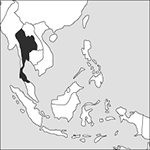
Source: MAPS IN MINUTES™ © RH Publications (1997)
Capital:
Bangkok
Area:
513,120 sq km (198,117 sq miles)
Population:
67,448,120 (2013 est)
Currency:
1 baht = 100 satang
Religions:
Buddhist 93.6%; Muslim 4.9%; Christian 1.2%
Ethnic Groups:
Thai 95.9%; Burmese 2.0%
Languages:
Thai (official); Burmese; minority languages
International Organizations:
UN; ASEAN; Colombo Plan; Non‐Aligned Movement; WTO
A country in south‐east Asia bounded by Myanmar (Burma), Laos, and Cambodia, and, in the south, Malaysia.
Physical
The country extends more than halfway down the Malay Peninsula and its north–south length is over 1600 km (1000 miles). The north is hilly and covered with dense forest. In the centre is a great, low‐lying plain threaded with rivers, which drain into the Gulf of Thailand. This is densely cultivated, with paddy fields, which yield fish as well as rice; further south, rubber is grown.
Economy
Although the economy was dominated by agriculture until the late 20th century, almost half of Thailand’s GDP is now contributed by industry. In recent years the country has experienced steady economic growth, based on exports of electronics, agricultural products, vehicles and parts, and processed foods. Other industries include tourism, textiles, and clothing. Rice, once the leading export, is still the most important crop.
History
The Thais, akin to the Shans and Lao, originated in the Yunnan province of south‐west China. Their name means ‘free’. Mongol pressure accelerated their southward movement from Yunnan. They set up kingdoms in Sukhotai and Chiengmai, formerly under Khmer rule, became Theravada Buddhists, and adopted an Indian script. About 1350 Ayuthia became the capital of a new Thai kingdom which, after prolonged fighting, captured Angkor in 1431. Ayuthia ruled much of Cambodia and at times Tenasserim and nothern Malaya. Wars with Burma, whose kings coveted Ayuthia’s sacred white elephants, brought no lasting loss of Thai territory.
Among Europeans who became active in Ayuthia the French were dominant. In 1684 Thai envoys presented Louis XIV with elephants, rhinoceroses, and a letter engraved on gold. The Burmese finally destroyed Ayuthia in 1767. Under the leadership of General Taskin, the Burmese were expelled from Siam by about 1777. His successor, General Chakri (later Rama I) founded the Chakri dynasty and established Bangkok as his capital. The Chakri dominated much of Laos and northern Malaya and succeeded in maintaining their country’s independence through a policy of conciliation, ceding their vassal state in Laos and Cambodia to France in the late 19th and early 20th centuries. In the reigns of Mongkut (1851–68) and Chulalongkorn (1868–1910) Thailand achieved substantial modernization in both the administrative and economic spheres. The middle class produced by the modernization process became intolerant of absolute royal rule, and an economic crisis in 1932 produced a bloodless coup which left the Chakri dynasty on the throne but transferred power to a constitutional government. Although technically allied to Japan during World War II, Thailand retained western friendship because of prolonged guerrilla resistance to Japanese forces. Until the early 1970s the country was largely ruled by the army, Marshal Pibul Songgram maintaining near personal rule from 1946 to 1957. Severe rioting resulted in a partial move to civilian government in 1973 and the introduction of a democratic constitution in 1974, but the threat of communist aggression, particularly on its borders with Cambodia, allowed a pronounced military influence. Following a military coup in 1991 General Suchinda Kraprayoon was appointed Prime Minister and imposed a military crackdown. This resulted in riots, arrests, and the killing of demonstrators, before King Bhumibol (ruled 1946–2016) was able to restore stability; Suchinda resigned and civilian political parties were re‐legalized. Elections in September 1992 were won by a coalition of pro‐democracy parties and the leader of the Democrat Party, Chuan Leekpai, became Prime Minister. Following elections in 1996 Chavalat Yongchaiyudh became Prime Minister but Chuan Leekpai returned in the wake of the financial crisis of 1997. Taksin Shinawatra, a wealthy businessman, was elected Prime Minister in 2001 and 2005. Thailand was severely affected by the Indian Ocean tsunami in 2004, with over 8,000 people being killed. Accusations of abuse of power by Taksin led him to call fresh elections in 2006, which were boycotted by the opposition parties and subsequently declared invalid. Taksin was ousted by a military coup later in 2006, and since that time Thai politics has been dominated by a struggle between his supporters and opponents, with both sides mobilizing mass demonstrations. In 2011 Taksin’s sister, Yingluck Shinawatra, became prime minister. Her administration faced concerted protest, particularly over legislation that would grant an amnesty to Taksin, and in 2014 the country’s Constitutional Court ordered her to stand down for abuse of position. The military then took control and imposed martial law, insisting that this was only a temporary measure. A new constitution was approved in a referendum in 2016. In that year, King Bhumibol, the world’s longest reigning monarch and highly revered in Thailand, died. He was succeeded by his son King Maha Vajiralongkorn, who had a reputation as a playboy. The king signed a modified version of the approved constitution in 2017, and elections are planned for 2018. Meanwhile the economy has fallen significantly behind its neighbours; suppression of free speech and opposition politics hascontinued, and structural and economic reforms promised by the military leaders have yet to materialize.
- stem group
- stemmer
- stemming
- stem reptiles
- stenching
- Stenian
- steno-
- Steno, Nicolaus
- Steno, Nicolaus (1638–87)
- stenothermal
- stenotopic
- Stensen, Niels
- STEP
- step
- step diagram
- step-down transformer
- step faulting
- step function
- step-growth polymerization
- Stephan Dushan (1308–55)
- Stephan, Frederick Franklin (1903–71)
- Stephanian
- Stephano
- Stephan’s Quintet
- Stephen (1097–1154)